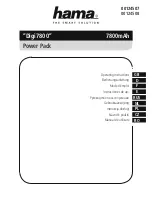
Joist Hanger
The optional joist hanger accessory
4
will allow
you to conveniently attach your tool to a joist,
or other convenient support when not in use.
The joist hanger
4
can be attached to either
side of the tool by securing it with a mounting
screw. Always make sure you securely tighten
the mounting screw before use (Fig.1).
When using the joist hanger
always be aware that the
accessory is exposed.
Always hang the tool in
an area where yourself and bystanders can not
accidently make contact with the accessory.
To reduce the risk of injury, use care in
selecting the location for hanging the tool.
•
Select a suitably sized and shaped object that
will provide adequate hanging stability. An
unstable hanging surface could result in the
tool unexpectedly falling.
•
Insure that the tool is hung out of the way of
walkways and working areas with
bystanders. The tool could be bumped or a
bystander could become entangled causing
the tool to unexpectedly fall.
To reduce the risk of injury,
Do not use the joist hanger if
it appears damaged or deformed.
This could
result in unstable hanging and the tool
unexpectedly falling.
14
Operating Instructions
The torque build-up depends on the following
factors:
• Hardness of the bolts/nuts.
• Type of washer (disk washer, spring
washer, seal).
• Hardness of the material to be joined.
• Lubricating effect at the surfaces of the
junction.
This leads to the following application cases:
Hard joining application:
The joining of metal
to metal with a disk washer. The maximum
t o r q u e i s r e a c h e d a f t e r a r e l a t i v e s h o r t
impacting/tightening action.
Medium joining application:
The joining of
metal to metal when using spring ring washer,
disk spring washer, stud bolts or bolts/nuts
with conical seats.
Soft joining application:
The joining of e.g.
metal to wood or insulation material.
For middle or soft joining cases, the maximum
tightening torque is less than for hard cases.
T h e r e f o r e ,
a
l o n g e r
i m p a c t i n g /
tightening action is necessary to arrive at the
maximum tightening torque.
Note:
Ensure that no metal particles enter the
power tool. After working at a low speed for an
extended period, you should operate the
p o w e r t o o l a t t h e m a x i m u m s p e e d f o r
approximately three minutes without load to
cool it down.
COLD WEATHER USE (32°F)
Due to the lubrication used in the impacting
mechanism, the tool should be run for three
minutes at no load prior to actual usage. This
will warm the lubricant and provide better
performance.















































